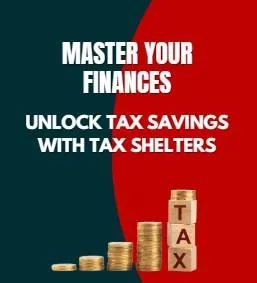
Unlock your savings with Tax Shelters
Understanding Tax Shelters:
A Path to Financial Freedom
For many seeking financial freedom, understanding tax shelters can be a game-changer. Tax shelters are strategies or accounts that allow individuals to reduce their taxable income, thereby minimizing the amount of taxes they owe to the government. By taking advantage of these options, you can efficiently manage your income, retain your hard-earned dollars, and invest in your future.
So, what exactly are tax shelters? At their core, they involve various investment vehicles or approaches that legalistically reduce taxable income. The concept is to encourage investment and savings by providing individuals with methods to legally avoid excessive taxation on their assets. The tax shelters available to Canadians can range from formal accounts to specific incentive programs designed to promote saving for retirement and education.
One of the most well-known tax shelters in Canada is the Registered Retirement Savings Plan (RRSP). Contributions to an RRSP are tax-deductible, meaning that you can subtract what you put into the plan from your taxable income for the year. This is especially useful for higher earners, as it can significantly lower the amount of tax owed. Additionally, the investments within an RRSP grow tax-deferred until withdrawal, usually at retirement when most people are in a lower tax bracket.
Another popular option is the Tax-Free Savings Account (TFSA). Introduced in 2009, the TFSA allows Canadians to contribute a certain amount each year (currently $6,500 for 2023; check for updates). The money you put into a TFSA grows tax-free, and withdrawals are also tax-free. This flexibility makes the TFSA an attractive option, allowing you to save for various goals, be it a vacation, a home down payment, or simply an emergency fund.
Education is another area where tax shelters come into play, thanks to the Registered Education Savings Plan (RESP). The RESP encourages saving for a child's post-secondary education. Contributions to an RESP are not tax-deductible, but the earnings grow tax-deferred until withdrawal, and the government provides a Canada Education Savings Grant (CESG) that matches a percentage of contributions, further boosting your savings for college.
Moreover, Canadians should consider using Investment Accounts like the Tax-Advantaged Accounts (TAA), which groups various investments such as stocks, bonds, and mutual funds under a tax-efficient structure. Since capital gains within these accounts are taxed at a lower rate than ordinary income, savvy investors can leverage this to their advantage to enhance their wealth while subjected to lower tax.
While these tax shelter options can provide significant benefits, it’s crucial to approach them with a strategic mindset. Understanding the limits and regulations governing each option is essential. Over-contributing to an RRSP or TFSA can lead to penalties. Similarly, failing to withdraw funds before they mature in an RESP could mean missing out on critical education funding.
In conclusion, for Canadians on the path to financial freedom, leveraging tax shelters can provide a robust strategy for wealth accumulation. By investing in RRSPs, TFSAs, RESPs, and other specialized accounts, individuals can reduce their taxable income and effectively grow their savings. This kind of financial planning not only helps in mitigating tax liabilities but also paves the way for a secure financial future. With careful consideration and informed choices, tax shelters can act as powerful tools in your journey towards achieving financial independence.